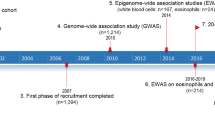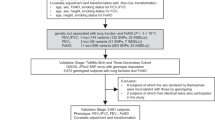Abstract
Endotoxin exposure may have a protective effect against asthma and atopy. An Asp299Gly polymorphism in the Toll-like receptor 4 (TLR4) gene reduces responsiveness to endotoxin. This study determined the effect of TLR4 polymorphism on the risk and severity of asthma and atopy. In all, 336 UK Caucasian families with ≥2 affected sibs (physician's diagnosis of asthma and current medication use) and 179 Caucasians without asthma or a family history of asthma were genotyped using ARMS-PCR. No association of the TLR4 polymorphism was found with the risk of developing asthma, either in parent-affected sibling trios, or in case–control analyses (P>0.05). In the first affected asthmatic siblings, the atopy severity score (based on size and number of positive skin-prick tests and specific IgE) was higher in those with the Asp/Gly or Gly/Gly genotypes (mean 1.8, s.d. 1.1, n=39) compared to those with the Asp/Asp genotype (mean 1.2, s.d. 1.0, n=279) (P=0.003, t-test). No associations were found with total IgE, FEV1 % predicted, slope of FEV1 response to methacholine or asthma severity score (P>0.05). This study confirms the previously observed lack of association of TLR4 polymorphisms with asthma. In contrast, the findings suggest that genetically determined hyporesponsiveness to endotoxin may increase atopy severity.
This is a preview of subscription content, access via your institution
Access options
Subscribe to this journal
Receive 6 digital issues and online access to articles
$119.00 per year
only $19.83 per issue
Buy this article
- Purchase on Springer Link
- Instant access to full article PDF
Prices may be subject to local taxes which are calculated during checkout
Similar content being viewed by others
References
Holgate ST . The epidemic of allergy and asthma. Nature 1999; 402 (Suppl): B2–B4.
Strachan DP . Family size, infection and atopy: the first decade of the ‘hygiene hypothesis’. Thorax 2000; 55 (Suppl 1): S2–S10.
Strachan DP . Hay fever, hygiene, and household size. BMJ 1989; 299: 1259–1260.
Liu AH . Endotoxin exposure in allergy and asthma: reconciling a paradox. J Allergy Clin Immunol 2002; 109: 379–392.
von Mutius E . Environmental factors influencing the development and progression of pediatric asthma. J Allergy Clin Immunol 2002; 109: S525–S532.
Liu AH, Murphy JR . Hygiene hypothesis: fact or fiction? J Allergy Clin Immunol 2003; 111: 471–478.
Gereda JE, Leung DY, Thatayatikom A et al. Relation between house-dust endotoxin exposure, type 1 T-cell development, and allergen sensitisation in infants at high risk of asthma. Lancet 2000; 355: 1680–1683.
Gehring U, Bischof W, Fahlbusch B, Wichmann HE, Heinrich J . House dust endotoxin and allergic sensitization in children. Am J Respir Crit Care Med 2002; 166: 939–944.
Braun-Fahrlander C, Riedler J, Herz U et al. Environmental exposure to endotoxin and its relation to asthma in school-age children. N Engl J Med 2002; 347: 869–877.
Beutler B . Innate immune responses to microbial poisons: discovery and function of the Toll-Like receptors. Annu Rev Pharmacol Toxicol 2003; 43: 609–628.
Arbour NC, Lorenz E, Schutte BC et al. TLR4 mutations are associated with endotoxin hyporesponsiveness in humans. Nat Genet 2000; 25: 187–191.
Raby BA, Klimecki WT, Laprise C et al. Polymorphisms in toll-like receptor 4 are not associated with asthma or atopy-related phenotypes. Am J Respir Crit Care Med 2002; 166: 1449–1456.
Kiechl S, Lorenz E, Reindl M et al. Toll-like receptor 4 polymorphisms and atherogenesis. N Engl J Med 2002; 347: 185–192.
Agnese DM, Calvano JE, Hahm SJ et al. Human toll-like receptor 4 mutations but not CD14 polymorphisms are associated with an increased risk of gram-negative infections. J Infect Dis 2002; 186: 1522–1525.
Lorenz E, Mira JP, Frees KL, Schwartz DA . Relevance of mutations in the TLR4 receptor in patients with Gram-negative septic shock. Arch Intern Med 2002; 162: 1028–1032.
Sayers I, Barton S, Rorke S et al. Allelic association and functional studies of promoter polymorphism in the leukotriene C4 synthase gene (LTC4S) in asthma. Thorax 2003; 58: 417–424.
Werner M, Topp R, Wimmer K et al. TLR4 gene variants modify endotoxin effects on asthma. J Allergy Clin Immunol 2003; 112: 323–330.
Pearce N, Pekkanen J, Beasley R . How much asthma is really attributable to atopy? Thorax 1999; 54: 268–272.
Davies DE, Wicks J, Powell RM, Puddicombe SM, Holgate ST . Airway remodeling in asthma: new insights. J Allergy Clin Immunol 2003; 111: 215–225.
Van Eerdewegh P, Little RD, Dupuis J et al. Association of the ADAM33 gene with asthma and bronchial hyperresponsiveness. Nature 2002; 418: 426–430.
Holloway JW, Rorke S, Beghé B, Holgate ST . Genetic influences on asthma severity In: Szefler SJ, Leung DYM (eds). Severe Asthma: Pathogenesis and Clinical Management. Marcel Dekker: New York, 2001 pp 19–38.
Ye S, Dhillon S, Ke X, Collins AR, Day IN . An efficient procedure for genotyping single nucleotide polymorphisms. Nucleic Acids Res 2001; 29: E88–E98.
Acknowledgements
We thank the patients and families who participated in this study. The collection of families was funded by Genome Therapeutics Corporation and Schering-Plough. IAY was supported by an Allen+Hanburys/Thoracic Society of Australia and New Zealand Respiratory Research Fellowship. JWH was supported by a Medical Research Council (MRC) Research Training Fellowship.
Author information
Authors and Affiliations
Corresponding author
Additional information
Contributions of authors
ST Holgate, JB Clough and TP Keith designed the original study in which the subjects were recruited. JW Holloway and IA Yang initiated this study of the TLR4 polymorphism. IA Yang and JA Cakebread performed the genotyping. SJ Barton and S Rorke undertook the statistical analysis. IA Yang and JW Holloway drafted the report. All authors approved the final version of this report.
Contributions of the funding support
Genome Therapeutics Corporation and Schering-Plough were responsible for the design of the original study and data collection. The funding bodies had no role in the genotyping, data analysis or writing of the report.
Rights and permissions
About this article
Cite this article
Yang, I., Barton, S., Rorke, S. et al. Toll-like receptor 4 polymorphism and severity of atopy in asthmatics. Genes Immun 5, 41–45 (2004). https://doi.org/10.1038/sj.gene.6364037
Received:
Revised:
Accepted:
Published:
Issue Date:
DOI: https://doi.org/10.1038/sj.gene.6364037
Keywords
This article is cited by
-
Toll-like Receptor 4 Pathway Polymorphisms Interact with Pollution to Influence Asthma Diagnosis and Severity
Scientific Reports (2018)
-
Association of TLR1, TLR2, TLR4, TLR6, and TIRAP polymorphisms with disease susceptibility
Immunologic Research (2015)
-
The effect of CD14 and TLR4 gene polimorphisms on asthma phenotypes in adult Turkish asthma patients: a genetic study
BMC Pulmonary Medicine (2014)
-
Positive link between variant Toll-like receptor 4 (Asp299Gly and Thr399Ile) and colorectal cancer patients with advanced stage and lymph node metastasis
Tumor Biology (2014)
-
A systematic review of CD14 and toll-like receptors in relation to asthma in Caucasian children
Allergy, Asthma & Clinical Immunology (2013)



